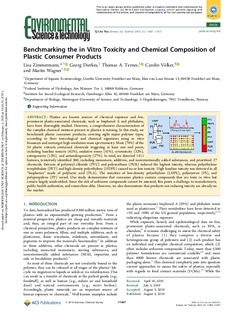Benchmarking the in Vitro Toxicity and Chemical Composition of Plastic Consumer Products
| dc.contributor.author | Zimmermann, Lisa | |
| dc.contributor.author | Dierkes, Georg | |
| dc.contributor.author | Ternes, Thomas A | |
| dc.contributor.author | Völker, Carolin | |
| dc.contributor.author | Wagner, Martin | |
| dc.date.accessioned | 2020-02-03T13:02:47Z | |
| dc.date.available | 2020-02-03T13:02:47Z | |
| dc.date.created | 2019-11-12T09:24:22Z | |
| dc.date.issued | 2019 | |
| dc.identifier.citation | Environmental Science and Technology. 2019, 53 (19), 11467-11477. | nb_NO |
| dc.identifier.issn | 0013-936X | |
| dc.identifier.uri | http://hdl.handle.net/11250/2639318 | |
| dc.description.abstract | Plastics are known sources of chemical exposure and few, prominent plastic-associated chemicals, such as bisphenol A and phthalates, have been thoroughly studied. However, a comprehensive characterization of the complex chemical mixtures present in plastics is missing. In this study, we benchmark plastic consumer products, covering eight major polymer types, according to their toxicological and chemical signatures using in vitro bioassays and nontarget high-resolution mass spectrometry. Most (74%) of the 34 plastic extracts contained chemicals triggering at least one end point, including baseline toxicity (62%), oxidative stress (41%), cytotoxicity (32%), estrogenicity (12%), and antiandrogenicity (27%). In total, we detected 1411 features, tentatively identified 260, including monomers, additives, and nonintentionally added substances, and prioritized 27 chemicals. Extracts of polyvinyl chloride (PVC) and polyurethane (PUR) induced the highest toxicity, whereas polyethylene terephthalate (PET) and high-density polyethylene (HDPE) caused no or low toxicity. High baseline toxicity was detected in all “bioplastics” made of polylactic acid (PLA). The toxicities of low-density polyethylene (LDPE), polystyrene (PS), and polypropylene (PP) varied. Our study demonstrates that consumer plastics contain compounds that are toxic in vitro but remain largely unidentified. Since the risk of unknown compounds cannot be assessed, this poses a challenge to manufacturers, public health authorities, and researchers alike. However, we also demonstrate that products not inducing toxicity are already on the market. | nb_NO |
| dc.language.iso | eng | nb_NO |
| dc.publisher | American Chemical Society | nb_NO |
| dc.rights | Attribution-NonCommercial-NoDerivatives 4.0 Internasjonal | * |
| dc.rights.uri | http://creativecommons.org/licenses/by-nc-nd/4.0/deed.no | * |
| dc.title | Benchmarking the in Vitro Toxicity and Chemical Composition of Plastic Consumer Products | nb_NO |
| dc.type | Journal article | nb_NO |
| dc.type | Peer reviewed | nb_NO |
| dc.description.version | publishedVersion | nb_NO |
| dc.source.pagenumber | 11467-11477 | nb_NO |
| dc.source.volume | 53 | nb_NO |
| dc.source.journal | Environmental Science and Technology | nb_NO |
| dc.source.issue | 19 | nb_NO |
| dc.identifier.doi | 10.1021/acs.est.9b02293 | |
| dc.identifier.cristin | 1746324 | |
| dc.description.localcode | This is an open access article published under a Creative Commons Non-Commercial No Derivative Works (CC-BY-NC-ND) Attribution License, which permits copying and redistribution of the article, and creation of adaptations, all for non-commercial purposes. | nb_NO |
| cristin.unitcode | 194,66,10,0 | |
| cristin.unitname | Institutt for biologi | |
| cristin.ispublished | true | |
| cristin.qualitycode | 2 |
Files in this item
This item appears in the following Collection(s)
-
Institutt for biologi [2569]
-
Publikasjoner fra CRIStin - NTNU [38047]

